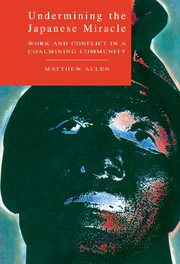Book contents
- Frontmatter
- Contents
- List of Plates
- List of Maps
- List of Figures
- Acknowledgements
- Glossary
- List of abbreviations
- Notes on translation and anonymity
- Map 1
- Map 2
- Introduction
- 1 Chikuho: A Short Description
- 2 The Chikuho Revivalists
- 3 Idegawa
- 4 A Short History of Coalmining: Chikuho in Context
- 5 The Picture Show Man
- 6 A Culture of Violence
- 7 H-san Mine: Violence and Repression
- 8 The Bathing Master
- 9 Labour Conflict: The Case of the K-san Union Action
- 10 D-san and the Students
- 11 Mizuno
- 12 The Y-san Disaster
- 13 Sono
- 14 Welfare
- 15 Welfare in Chikuho
- 16 A Yakuza Story
- Conclusion
- Bibliographical Essay
- Bibliography
- List of Informants
- Index
- Plate section
7 - H-san Mine: Violence and Repression
Published online by Cambridge University Press: 28 October 2009
- Frontmatter
- Contents
- List of Plates
- List of Maps
- List of Figures
- Acknowledgements
- Glossary
- List of abbreviations
- Notes on translation and anonymity
- Map 1
- Map 2
- Introduction
- 1 Chikuho: A Short Description
- 2 The Chikuho Revivalists
- 3 Idegawa
- 4 A Short History of Coalmining: Chikuho in Context
- 5 The Picture Show Man
- 6 A Culture of Violence
- 7 H-san Mine: Violence and Repression
- 8 The Bathing Master
- 9 Labour Conflict: The Case of the K-san Union Action
- 10 D-san and the Students
- 11 Mizuno
- 12 The Y-san Disaster
- 13 Sono
- 14 Welfare
- 15 Welfare in Chikuho
- 16 A Yakuza Story
- Conclusion
- Bibliographical Essay
- Bibliography
- List of Informants
- Index
- Plate section
Summary
H-san (mine) operated from the early 1920s through to 1961, the year after a dramatic mineshaft flood in which 67 miners died. Throughout this period the mine was renowned as one of the most violent of all Japanese mines. The expression asseiyama (‘pressure mine’) was first used in relation to this mine, and referred to the system of indentured, and often forced, labour. The number of workers killed in the mine in incidents concerning the rōmu is difficult to estimate, but one source has put the figure at more than 500 over a 45-year period.
When the flooding occurred locals were outraged at the lack of action taken by management to commit the necessary resources to exhume the bodies of the dead miners after it was finally decided that there could be no survivors. The memory of this lack of goodwill is still strong within the local community, and has a powerful impact on the way the company is remembered in Kawasaki.
The power of the press to influence the course of events is an issue that is often neglected in anthropology. Over time, as memories fade, we become more reliant on written accounts of the time to understand the past. In effect these accounts become history. To understand the nature of these historical ‘truths’, we must deal with the media accounts of the time. I shall use the newspaper reports from the NishiNihon Shinbun, the largest of the Kyushu newspapers (circulation five million daily), and the newspaper most in touch with local events, to describe the mining disaster at H-san. The newspaper accounts are relevant because they show how news of the accident was communicated to the population.
- Type
- Chapter
- Information
- Undermining the Japanese MiracleWork and Conflict in a Japanese Coal-mining Community, pp. 124 - 152Publisher: Cambridge University PressPrint publication year: 1994



